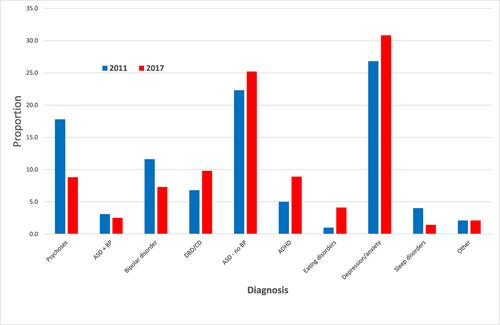Antipsychotic prescribing patterns in children and adolescents attending Australian general practice in 2011 and 2017
Abstract
Background
Antipsychotics are increasingly prescribed to children and adolescents worldwide, but little is known about reasons for prescribing. We aimed to examine patterns of paediatric antipsychotic prescribing in Australian primary care services in 2011 and 2017, including diagnoses, sociodemographic characteristics, off-label prescribing, and psychotropic co-prescribing.
Methods
Retrospective analysis of electronic health records (EHRs) using a large Australian general practice database (MedicineInsight). Diagnoses of mental disorders were extracted from EHRs and associated with antipsychotic prescriptions within the same calendar year for three age-groups: 0–9, 10–14, and 15–18-year-olds.
Results
In 2017, children/adolescents with mental health diagnoses were more likely to be prescribed antipsychotics (2.9% of 27,412 patients) than in 2011 (2.0% of 8418 patients; absolute difference +0.9, 95% CI + 0.5, +1.4). The likelihood was greater for patients with bipolar disorders (21.6% vs. 41.5%), eating disorders (1.1% vs. 7.2%), and autism without behavioural problems (3.7% vs. 6.1%). Depression/anxiety (adjusted 26.8% of patients 2011; 30.8% 2017) was the most common diagnosis associated with antipsychotics in both years. Most antipsychotics were prescribed off-label (69.8% 2011; 79.7% 2017; absolute difference +9.8, 95% CI + 1.54, +18.4). Off-label prescribing increased most among those aged 15–18-years, females, and patients living in outer regional/remote/very remote communities and the most disadvantaged areas. The three most frequently prescribed antipsychotics in both years were risperidone, quetiapine, and olanzapine. Psychotropic co-prescribing among patients receiving antipsychotic prescriptions was approximately 69% in both years.
Conclusions
Prescribing antipsychotics for mental health diagnoses to children/adolescents attending Australian general practices was more frequent in 2017 than 2011, and most commonly associated with depression/anxiety diagnoses. In both years, most prescribing was off-label. The majority of patients were co-prescribed other classes of psychotropics along with antipsychotics.



 求助内容:
求助内容: 应助结果提醒方式:
应助结果提醒方式:


